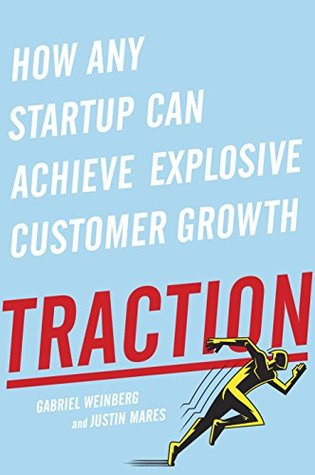More on this book
Community
Kindle Notes & Highlights
Read between
May 1 - June 22, 2022
Getting stories written about you in blogs and news outlets is a common SEO linking strategy.
However, I hit saturation with that channel strategy pretty quickly and it didn’t get me to the top. Something more creative was required.
Before we get started, let’s define traction. Traction is a sign that your company is taking off. It’s obvious in your core metrics: If you have a mobile app, your download rate is growing rapidly. If you’re running a subscription service, your monthly revenue is skyrocketing.
We call these customer acquisition channels traction channels.
Targeting Blogs
Publicity
Unconventional PR
Search Engine Marketing
Social and Display Ads
Offline Ads
Search Engine Optimization
Content Marketing
Email Marketing
Engineering as Marketing
Using engineering resources to acquire customers is a significantly underutilized way to get traction. Successful companies have built microsites, developed widgets, and created free tools that drive thousands of leads each month. We asked Dharmesh Shah, founder of HubSpot, to discuss how engineering as marketing has driven HubSpot’s growth to tens of thousands of customers through tools like its Marketing Grader.
Viral Marketing
Business Development
Sales
Affiliate Programs
Existing Platforms
Trade Shows
Offline Events
Speaking Engagements
Community Building
Having a product or service that your early customers love, but having no clear way to get more traction is a major problem. To solve this problem, spend your time constructing your product or service and testing traction channels in parallel.
attention. This is what we call the 50 percent rule: spend 50 percent of your time on product and 50 percent on traction.
If you don’t, then you risk realizing you’re in one of these traps too late to do anything useful.
The flip side is that if you focus on traction from the beginning, then you can figure out very quickly if you’re on the right track.
First, it helps you build the right product because you can incorporate knowledge from your traction efforts.
They often tell you what you want to hear.
This is exactly where most founders go wrong. They think because this money is leaking out that it is money wasted. Oppositely, this process is telling you where the real leaks are in your bucket (product).
These interactions also get you additional data, like what messaging is resonating with potential customers, what niche you might focus on first, what types of customers will be easiest to acquire, and what major distribution roadblocks you might run into.
At Marketo, not only did we have SEO [search engine optimization] in place even before product development, we also had a blog. We talked about the problems we aimed to solve…. Instead of beta testing a product, we beta tested an idea and integrated the feedback we received from our readers early on in our product development process.
Before you can set about getting traction, you have to define what traction means for your company.
You need to set a traction goal.
At the earliest stages, this traction goal is usually to get enough traction to either raise f...
This highlight has been truncated due to consecutive passage length restrictions.
Phase I—making something people want Phase II—marketing something people want Phase III—scaling your business
Phase I is very product focused and involves pursuing initial traction while also building your initial product. This often means getting traction in ways that don’t scale—giving talks, writing guest posts, emailing people you have relationships with, attending conferences, and doing whatever you can to get in front of customers.
Actually startups take off because the founders make them take off….
If you want to add 100,000 new customers, with conversion rates between 1 and 5 percent, you’re looking at reaching 2 to 10 million people in a targeted marketing campaign—those are huge numbers! That’s why traction channels like community building and viral marketing can be so powerful: they scale with the size of your user base and potential market.
That’s why it is actually useful to look at AngelList and look at companies who just got funded; that will give you an idea of where the bar is right now.
When pursuing funding, first contact individuals who intimately understand what you’re working on (perhaps because they have worked on or invested in something similar before).
There are many reasons why investors may say no that are simply beyond your control (investment goals, timing, expertise, etc.).
We strongly believe that many startups give up way too early. A lot of startup success hinges on choosing a great market at the right time.
Are they early adopters in a huge market or are they outliers?
The first step in Bullseye is brainstorming every single traction channel. If you were to advertise offline, where would be the best place to do it? If you were to give a speech, who would be the ideal audience? Imagine what success would look like in each channel, and write it down in your outer ring.
For each channel, you should identify one decent channel strategy that has a chance of moving the needle. For example, social ads is a traction channel. Specifically running ads on reddit, Twitter, or Facebook is a channel strategy within social ads. Through brainstorming, identify the best channel strategy you can think of in each of the nineteen traction channels.
The second step in Bullseye is running cheap traction tests in the channels that seem most promising.
we don’t want you to waste valuable time testing channels sequentially when you can do so equally well in parallel.


